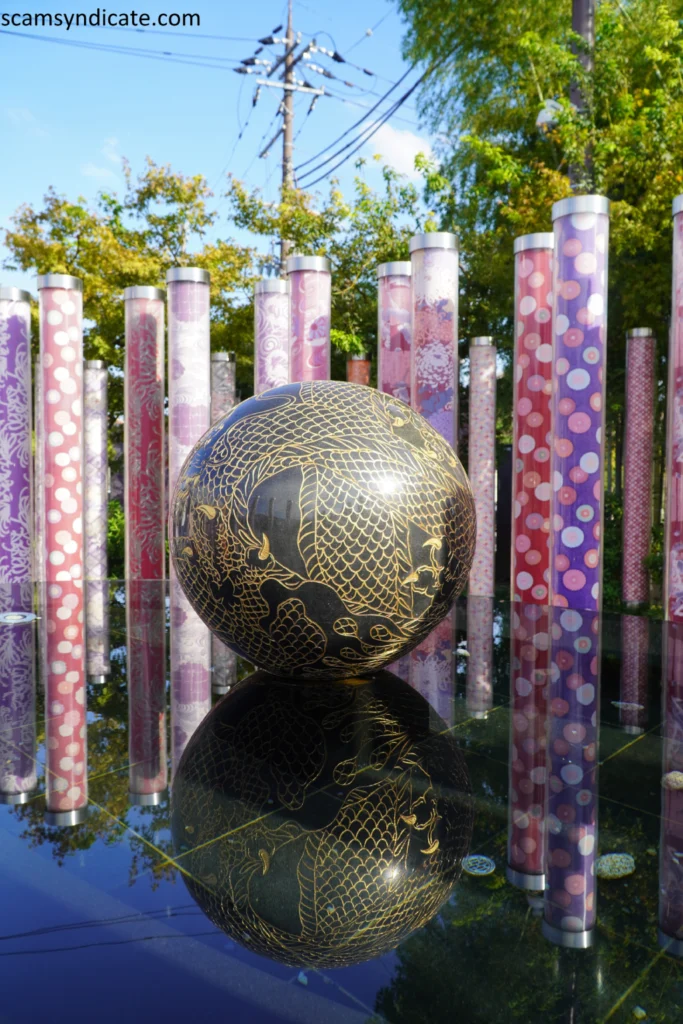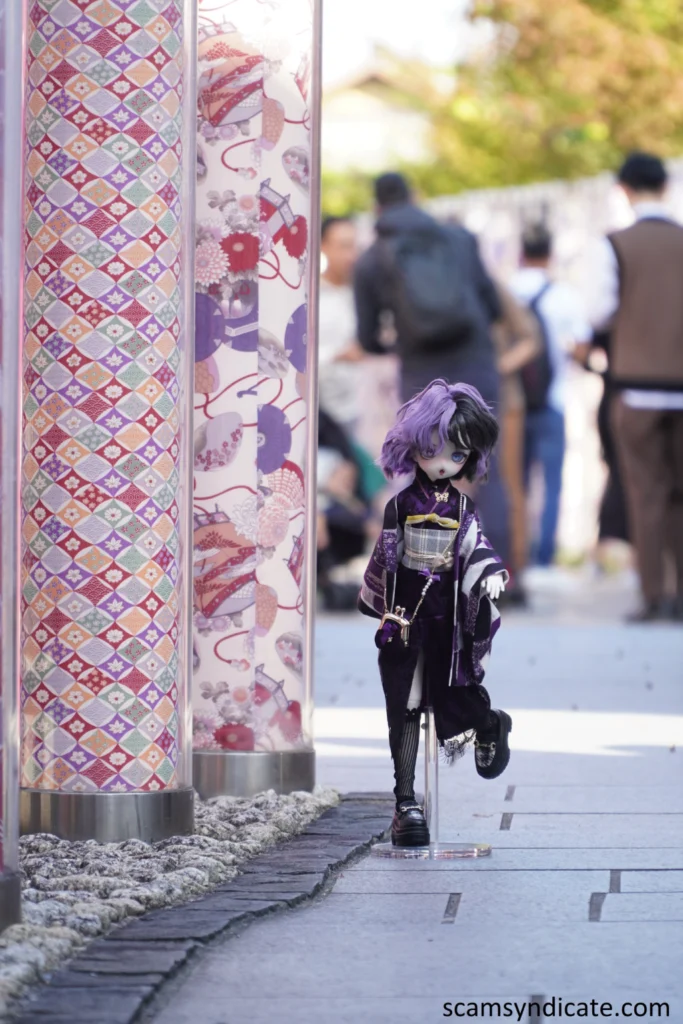Travel in November 2023 | 2023年十一月的旅行
Kyoto Japan 日本京都

As Japan’s imperial capital for over 1,000 years, Kyoto is where the soul of traditional Japan breathes through golden temples, whispering bamboo groves, and the delicate art of the geisha. With 17 UNESCO World Heritage Sites, the city unfolds like a scroll painting—from the vermilion gates of Fushimi Inari Shrine’s endless torii tunnels to Kinkaku-ji’s gold-leaf pavilion reflecting in a mirror pond. By day, witness monks chant at Zen gardens of Ryoan-ji, or stroll through Gion’s wooden machiya houses where apprentice geiko still practice the shamisen. By night, lantern-lit Pontocho Alley serves kaiseki cuisine on platforms over the Kamo River. Kyoto’s magic lies in its seasonal transformations: cherry blossoms framing Philosopher’s Path in spring, fireflies dancing at Shimogamo Shrine in summer, maple leaves setting Kiyomizu-dera ablaze in autumn, and snow-capped pagodas in winter. Whether participating in a tea ceremony wearing rented kimono, learning samurai swordsmanship, or tasting matcha desserts that are edible art, Kyoto doesn’t just preserve history—it lets you live it through all five senses.
这座做了1000多年日本首都的古都,让传统之美在金阁寺的倒影、岚山竹林的沙响与舞妓的簪花间鲜活延续。拥有17处世界遗产的京都,本身就是一幅展开的绘卷——从伏见稻荷千本鸟居的朱红隧道,到龙安寺枯山水庭园的禅意。白天可观摩僧人在苔寺诵经,或徘徊在祇园艺伎出没的町屋老巷;夜晚则能在鸭川畔的先斗町料亭,品尝悬于河上的怀石料理。京都真正的魔力在于四季剧变:春日哲学之道的樱花雨,夏日下鸭神社的萤火虫,秋日清水寺燃烧般的红叶,冬日银装素裹的五重塔。无论是穿着租赁和服体验茶道、学习武士刀法,还是品尝堪称艺术品的抹茶甜点,京都从不把历史封存于展柜,而是让你用五感去呼吸这份千年风雅。
12D11N trip to Kansai Part 3
🏯 Day6-7: Kyoto Time Travel
Nijo Castle’s Song
– The “nightingale floors” chirped underfoot – ancient security system! VR showed us shoguns walking these halls.
Kiyomizudera Dawn
– At 6AM, we had the iconic stage to ourselves. A monk gifted us “ichi-go ichi-e” talisman.
Fushimi Magic Hour
– Sunset set the torii gates ablaze! We found hidden fox ema plaques to write wishes.
🎋 Day8: Arashiyama Dreams
Bamboo Symphony
– 7AM竹林 was silent except for rustling leaves. A kimono photographer taught us creative angles.The Hidden Gem of Arashiyama Yoshimura
– Following tips from Instagram bloggers, we snagged the coveted second-floor window seat. As we savored our noodles while watching the Katsura River flow by, it suddenly clicked—this is what “Kyoto time” truly means. ~
🍢 Day9: Foodie Paradise
(Story continues…)


12天11夜关西之旅第三部分
🏯 Day6-7:京都·千年穿越
二条城的声音密码
– 踩在”夜莺地板”上,吱呀声就像鸟鸣!VR眼镜让我们看到德川家康当年在这里接见大名的场景。
清水寺的晨光特权
– 6点到达时,晨雾中的清水舞台只属于我们!僧人正在洒扫,送了我们写有”一期一会”的朱印。
伏见稻荷的魔法时刻
– 傍晚的千本鸟居像被点燃般绚烂!我们在奥社发现隐藏的狐狸绘马,写下了心愿~
🎋 Day8:岚山·竹梦记
7:00的竹林独奏
– 赶在游客前冲进竹林,露珠还在竹叶上打转!偶遇穿袴服的摄影师,教我们借位拍”托起渡月桥”的创意照。
岚山吉村的秘境
– 跟着ins博主的提示,找到二楼窗位。吃着面条看桂川流淌,突然明白什么是”京都时间”~
🍢 第9天:舌尖上的大阪
(故事待续…)
🏯 Central Kyoto 中央京都
🏰 Nijo Castle 二条城
A UNESCO World Heritage Site, Nijo Castle was built in 1603 as the residence of Tokugawa Ieyasu. Its ornate interiors and the famous “nightingale floors” are must-sees.
二条城是联合国教科文组织认定的世界遗产,建于1603年,是德川家康的京都住所。城内的华丽装饰与“夜莺地板”十分有名。


A UNESCO World Heritage Site, Nijo Castle was built in 1603 by Tokugawa Ieyasu.
Ninomaru Palace features the famous “nightingale floors,” which chirp when walked on to warn of intruders.
Ninomaru Garden is a beautiful strolling garden with a central pond and seasonal foliage.
二条城是世界文化遗产,由德川家康于1603年建造。
二之丸御殿以“夜莺地板”著称,踩上去会发出鸣叫声,是防盗设计。
二之丸庭园为池泉回游式庭园,四季风景不同,尤以春秋最佳。
📚 Kyoto International Manga Museum 京都国际漫画博物馆
A must-visit for anime and manga fans, housing thousands of Japanese comics you can freely browse.
动漫爱好者不可错过的漫画天堂,馆藏上万本漫画可供翻阅。
🏞 Shinsenen Temple 神泉苑
A tranquil temple with a pond garden, originally part of the Heian Palace.
曾是平安京御苑的一部分,池泉庭园宁静雅致,历史悠久。
👑 Kyoto Imperial Palace 京都御所
Former residence of the Emperor of Japan, this palace features elegant architecture and vast, peaceful gardens.
京都御所曾是日本天皇的居所,拥有优雅的建筑风格和广阔静谧的庭园。


🌸 Sento Imperial Palace 仙洞御所
Located near the Kyoto Imperial Palace, Sento was built for retired emperors. Access is only via guided tours.
仙洞御所位于京都御所旁,是为退位天皇修建的庭园,仅能通过预约导览参观。


🛍 Downtown Kyoto 市中心
🐟 Nishiki Market 锦市场
Known as “Kyoto’s Kitchen,” this narrow market street is full of local food, snacks, and culinary curiosities.
被称为“京都厨房”的锦市场是京都最热闹的美食街之一,聚集了各种地道小吃和特产。


🛒 Teramachi & Shinkyogoku Shopping Streets 寺町与新京极商店街
Two bustling parallel shopping arcades full of local souvenirs, fashion, and food.
京都市中心两条热闹的购物街,集购物、美食与文化于一体,是游客常逛之地。
🏮 Higashiyama District 东山地区
🛕 Hōkan-ji Temple 法观寺(八坂塔)
Known for its iconic five-story pagoda, Hōkan-ji (Yasaka Pagoda) is a photogenic landmark near Gion.
法观寺的五重塔是东山一带的地标,常出现在游客拍照和电影中,也被称为“八坂塔”。


🏯 Kiyomizu-dera 清水寺
One of Kyoto’s most famous temples, Kiyomizu-dera is best known for its wooden stage offering panoramic views of the city.
清水寺是京都最著名的寺庙之一,寺中高悬的木制舞台可俯瞰京都全景,是观赏红叶与樱花的胜地。


Iconic Kyoto temple with panoramic views.
Otowa Falls: Drink from its three streams for health, longevity, or success.
Sannen-zaka & Ninen-zaka: Charming historic slopes with traditional shops.
Kiyomizu Boardwalk: Wooden walkway that stretches into the hillside.
京都象征性寺庙之一。
音羽瀑布:三股清泉象征健康、长寿与成功。
三年坂与二年坂:古色古香的坡道,两侧商店林立。
清水板:悬于山坡之上的木板道,是清水寺的特色建筑。
🏯 Tofuku-ji Temple 东福寺
Known for its stunning Zen gardens and breathtaking autumn foliage.
以枯山水庭园和秋季红叶闻名,是京都赏枫名所之一。
⛩ Yasaka Shrine 八坂神社
A key shrine in Kyoto, it is especially popular during festivals like Gion Matsuri and is beautifully illuminated at night.
八坂神社是京都的重要神社之一,祇园祭等传统节庆期间尤为热闹,夜晚灯光点缀别有风味。


🌸 Maruyama Park 円山公园
A peaceful park near Yasaka Shrine, famous for cherry blossoms and evening strolls.
八坂神社旁的城市公园,春季樱花盛开,夜樱尤其美丽。


🎎 Hanamikoji Street 花见小路
This charming street in Gion is known for traditional tea houses and occasional geisha sightings.
花见小路是祇园地区代表性的街道,两旁是古老茶屋,有时还能遇见艺伎行走其间。


🏯 Kennin-ji Temple 建仁寺
Kyoto’s oldest Zen temple, known for its ceiling dragon painting and dry gardens.
京都最古老的禅宗寺庙,以天井上的双龙图和枯山水庭园闻名。
🌸 Gion 祇园
Kyoto’s historic entertainment district, home to geiko and maiko culture. Perfect for evening strolls.
祇园是京都最具历史的花街区,是艺伎和舞伎文化的发源地,夜晚漫步其中别有风情。


⛩ Tatsumi Shrine 辰巳大明神
A small, charming shrine nestled at a corner of the Gion geisha district.
祇园艺伎区中的小巧神社,位置隐秘却充满传统韵味。
🌉 Tatsumi Bridge 辰巳桥
A picturesque bridge in the Gion Shinbashi area, frequently featured in films and photos.
位于祇园新桥地区的古桥,是京都夜景与艺伎文化的代表场所。
🏞 Gion Shinbashi Area 祇园新桥地区
Kyoto’s best-preserved geisha district with cobbled streets, wooden teahouses, and seasonal lanterns.
最具古风的祇园街区,石板小路、茶屋与红灯笼营造出独特艺伎氛围。
🍶 Pontocho 先斗町
A narrow alley along the river famous for its atmospheric restaurants and traditional nightlife.
先斗町紧邻鸭川,是一家家传统日式餐厅林立的小巷,夜晚尤为热闹,气氛独特。


⛩ Southern Kyoto 南部京都
🦊 Fushimi Inari Taisha 伏见稻荷大社


Famous for its thousands of vermilion torii gates leading into the forested mountainside. A spiritual and photogenic destination.
伏见稻荷大社以数千座朱红色鸟居闻名,是京都最热门的打卡圣地之一,登山步道风景迷人。


🌄 Arashiyama Area 岚山地区
🎍 Bamboo Grove Path 竹林小径
A serene walking path through towering bamboo stalks—one of Kyoto’s most iconic and calming sights.
穿行于翠绿竹林间的小径,是岚山最经典的景观之一,宁静优美,十分适合拍照与放松。


⛩ Nonomiya Shrine 野宫神社
A small forest shrine once used by imperial princesses; famous for love blessings.
曾是未婚皇女净身之地,如今为求姻缘的热门神社,环境静谧。


🗿 Avalokitesvara Statue 千手观音像
A large statue of Kannon (Avalokitesvara) near Arashiyama, representing compassion and mercy.
位于岚山的大型观音像,是慈悲象征,吸引众多参拜者。
🔭 Arashiyama Park Observation Deck
Located on a hill just behind Togetsukyo Bridge, this observation deck offers panoramic views of the Katsura River, Arashiyama mountains, and the city below. It’s a peaceful spot, perfect for a short hike and ideal during cherry blossom or autumn foliage seasons.
位于渡月桥后方小山丘上的岚山公园展望台,可俯瞰桂川、岚山群山及远处市区风景。这里环境幽静,是轻松徒步的好去处,尤其在樱花盛开或红叶季节最为迷人。


🏯 Tenryu-ji Temple 天龙寺
A Zen temple and UNESCO site with beautifully landscaped gardens, adjacent to the Bamboo Grove.
天龙寺是世界文化遗产,以典雅的日式庭园著称,位于竹林小径旁,是参拜与赏景的好去处。


🌉 Togetsukyo Bridge 渡月桥
Literally meaning “Moon Crossing Bridge,” it offers picturesque views of the Katsura River and mountains, especially in spring and autumn.
渡月桥意为“跨月之桥”,横跨桂川,春赏樱花、秋观红叶,是岚山的浪漫象征。


🏞 Katsura River 桂川
A river flowing through Arashiyama, ideal for boat rides and riverside strolls.
流经岚山的主要河流,适合乘舟游览或沿岸散步。


🏞 Nakanoshima Park 中之岛公园
A riverside park located on a small island between the Katsura River’s two branches, right next to Togetsukyo Bridge. It offers tranquil walking paths, seasonal flowers, benches, and access to the Arashiyama Park Observation Deck. Ideal for cherry blossom viewing in spring.
位于桂川分流之间的小岛上,紧邻渡月桥,是一座宁静的河滨公园。园内设有步道、长椅与四季花卉,是春季赏樱的热门地点之一,同时也是前往岚山展望台的通道之一。
🐒 Arashiyama Monkey Park Iwatayama 岚山猴子公园(岩田山)
Located on Mt. Iwata across the river from central Arashiyama, this park is home to over 100 wild Japanese macaques. After a moderate 15–20 minute hike, visitors are rewarded with up-close views of monkeys and a panoramic view of Kyoto city.
位于桂川对岸岩田山上的猴子公园,栖息着百余只日本野生猕猴。登山约15至20分钟后可近距离观猴,山顶还设有观景平台,可俯瞰京都市景,是亲近自然与动物的好地方。
👘 Arashiyama Kimono Forest 岚山和服森林
Art installation featuring glowing kimono textile pillars near Arashiyama Station—stunning at night.
位于岚山站旁的和服森林由数百根布艺灯柱组成,夜晚点灯后尤为迷人,是打卡热点。


🚂 Sagano Romantic Train 嵯峨野游览小火车
A scenic train ride through the mountains and along the Hozugawa River, especially beautiful in autumn.
嵯峨野游览小火车穿越山间与保津川沿岸,是观赏自然四季变化的绝佳方式。
🚉 Arashiyama Station 岚山站
Convenient station near Tenryu-ji, the Bamboo Grove, and Kimono Forest.
临近天龙寺、竹林与和服森林,交通便利。


🚉 Saga Station 嵯峨站
Closest station to the Bamboo Grove, Arashiyama attractions, and the scenic train line.
靠近竹林小径和岚山主要景点,是搭乘游览小火车的交通枢纽。


🚉 Kameoka Station 龟冈站
The starting point of the Sagano Romantic Train, surrounded by rural charm.
嵯峨野小火车的起点,周围是宁静的乡村风光。